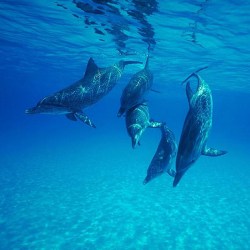Dolphins Have Amazing Cooperative Abilities

Many species in the wild can be found to cooperate, including when they hunt, raise their young or defend themselves from predators. The big question is whether the animals are strategically coordinating their behaviour or simply acting as individuals to accomplish the same goals at the same time? A new study suggests that bottlenose dolphins actively coordinate and that they learn to work together in synchronicity to solve a task or receive a reward.
Testing teamwork
The research took place at the Dolphin Research Centre in Florida where the researchers paired up the dolphins and had them swim across a lagoon and press an underwater button assigned to each dolphin at the same time. The dolphin trainers would stand alongside their dolphins at the opposite side of the lagoon to the buttons and then signal their dolphins to either press the button simultaneously or delay the action by 20 seconds after the first signal was given.
Learning to cooperate
If the dolphins pressed their respective buttons simultaneously, a success sound was played and they returned to their trainers where they were given fish and praised. If the dolphins pressed their buttons in a delayed manner a failure sound was emitted and the trainers then conducted then next trial. This meant the dolphins learned they had to work together to receive their reward and the goal was not simply about pressing their button.
Changing behaviour
This means even when they were sent off at different times the dolphins had to understand that in order to succeed they needed to press the button together. The intriguing question then arises of whether the dolphin that is sent of first would wait for the other dolphin before pressing the button and more importantly whether they could work out how to precisely coordinate to ensure the button was pressed simultaneously.
Swim fast, or coordinate?
What the researchers found was that the dolphins were able to work together very precisely even when being given the signal at different times. As the dolphins learned what the task was, their behaviour, strategy and coordination changed. The dolphins first had to understand the task was cooperative because they could not know that in order for them to succeed and be rewarded, they needed to press the buttons simultaneously.
Learning the game
The researchers helped the dolphins to learn by initially sending the dolphins to press the button simultaneously and then gradually begun increasing the delay between sending the dolphins. Once one dolphin understood the game and if the other was sent first, they were aware that their partner did not understand the game and so would not wait. This meant to begin with successful trials occurred not because the first dolphin was waiting, but because the second dolphin swam extremely fast and caught up. Once both dolphins understood the game, this behaviour changed and the timing of their presses became very precise with an average delay of just 370 milliseconds suggesting that both dolphins understood speed was not necessary for success by synchronicity was.
Synchrony in the wild
Wild dolphins exhibit synchronised behaviour in many different contexts. Mothers and calves for example surface together in order to breathe simultaneously. Males form alliances with other males and undertake coordinated displays which are amazingly precise and it is believed these displays promote coordination. The results of the study suggest the synchronised behaviour of wild dolphins is a generalised ability that can be applied to a variety of situations.



